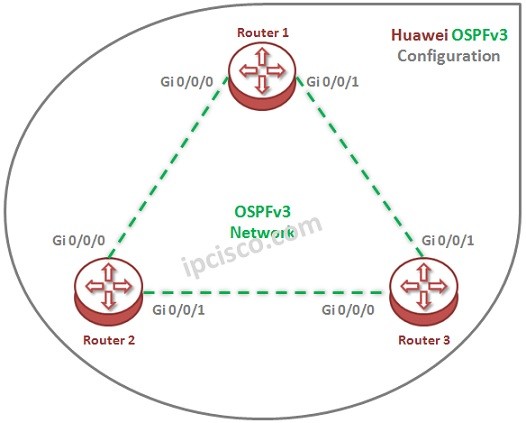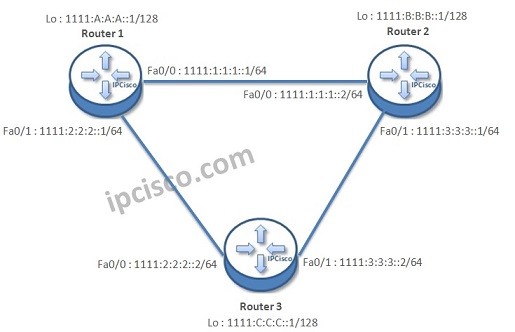OSPFv3 IPv6 OSPFv2 OSPFv2 OSPFv3
For OSPFv3 Configuration
1. Enabling Global IPv6 RoutingIPv6 Address Configuration
Now, let’s go to each COnfiguration steps one by one.
Firstly, we will enable global IPv6 ipv6 unicast-routing ” command.
Router 1 # config terminal
Router 1 (config) # ipv6 unicast-routing
Router 2 # config terminal
Router 2 (config) # ipv6 unicast-routing
Router 3 # config terminal
Router 3 (config) # ipv6 unicast-routing
Router 4 # config terminal
Router 4 (config) # ipv6 unicast-routing
Router 5 # config terminal
Router 5 (config) # ipv6 unicast-routing
Router 6 # config terminal
Router 6 (config) # ipv6 unicast-routing
Secondly, we will enable IPv6 under interfaces with “ipv6 enable ” command.
Router 1 (config) # interface fa0/0
Router 1 (config-if) # ipv6 enable
Router 1 (config-if) # interface fa0/1
Router 1 (config-if) # ipv6 enable
Router 1 (config-if) # interface fa0/1
Router 1 (config-if) # ipv6 enable
Router 2 (config) # interface fa0/0
Router 2 (config-if) # ipv6 enable
Router 2 (config-if) # interface fa0/1
Router 2 (config-if) # ipv6 enable
Router 3 (config) # interface fa0/0
Router 3 (config-if) # ipv6 enable
Router 3 (config-if) # interface fa0/1
Router 3 (config-if) # ipv6 enable
Router 3 (config-if) # interface fa0/1
Router 3 (config-if) # ipv6 enable
Router 4 (config) # interface fa0/0
Router 4 (config-if) # ipv6 enable
Router 4 (config-if) # interface fa0/1
Router 4 (config-if) # ipv6 enable
Router 5 (config) # interface fa0/0
Router 5 (config-if) # ipv6 enable
Router 6 (config) # interface fa0/0
Router 6 (config-if) # ipv6 enable
In the third step, we will do the IPv6 address configuration ipv6 address -ipv6address- eui-64 “ commands. The Link-local addresses Link-local addresses
Router 1 (config) # interface fa0/0
Router 1 (config-if) # ipv6 address 2001:1234:0:111::1/64 eui-64
Router 1 (config-if) # interface fa0/1
Router 1 (config-if) # ipv6 address 2001:1234:0:222::1/64 eui-64
Router 1 (config-if) # interface fa0/1
Router 1 (config-if) # ipv6 address 2001:1234:0:555::1/64 eui-64
Router 2 (config) # interface fa0/0
Router 2 (config-if) # ipv6 address 2001:1234:0:111::2/64 eui-64
Router 2 (config-if) # interface fa0/1
Router 2 (config-if) # ipv6 address 2001:1234:0:333::1/64 eui-64
Router 3 (config) # interface fa0/0
Router 3 (config-if) # ipv6 address 2001:1234:0:444::2/64 eui-64
Router 3 (config-if) # interface fa0/1
Router 3 (config-if) # ipv6 address 2001:1234:0:333::2/64 eui-64
Router 3 (config-if) # interface fa0/1
Router 3 (config-if) # ipv6 address 2001:1234:0:666::1/64 eui-64
Router 4 (config) # interface fa0/0
Router 4 (config-if) # ipv6 address 2001:1234:0:444::1/64 eui-64
Router 4 (config-if) # interface fa0/1
Router 4 (config-if) # ipv6 address 2001:1234:0:222::2/64 eui-64
Router 5 (config) # interface fa0/0
Router 5 (config-if) # ipv6 address 2001:1234:0:555::2/64 eui-64
Router 6 (config) # interface fa0/0
Router 6 (config-if) # ipv6 address 2001:1234:0:666::2/64 eui-64
Now, it is time to configure OSPFv3














Leave a Reply